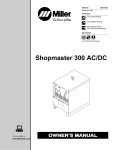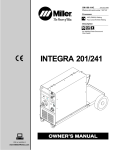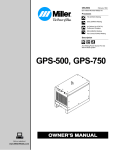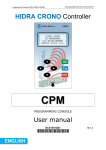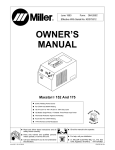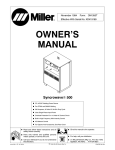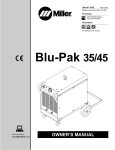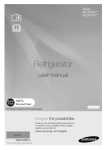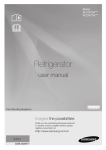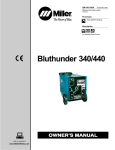Download Miller Electric Soft Start 2-2F Owner`s manual
Transcript
OM-189 112 January 1998 Eff. w/Serial Number ME144734 Processes TIG (GTAW) Welding Stick (SMAW) Welding Description Soft Start 2-2F 1 Visit our website at www.MillerWelds.com From Miller to You Thank you and congratulations on choosing Miller. Now you can get the job done and get it done right. We know you don’t have time to do it any other way. That’s why when Niels Miller first started building arc welders in 1929, he made sure his products offered long-lasting value and superior quality. Like you, his customers couldn’t afford anything less. Miller products had to be more than the best they could be. They had to be the best you could buy. Today, the people that build and sell Miller products continue the tradition. They’re just as committed to providing equipment and service that meets the high standards of quality and value established in 1929. This Owner’s Manual is designed to help you get the most out of your Miller products. Please take time to read the Safety precautions. They will help you protect yourself against potential hazards on the worksite. We’ve made installation and operation quick and easy. With Miller you can count on years of reliable service with proper maintenance. And if for some reason the unit needs repair, there’s a Troubleshooting section that will help you figure out what the problem is. The parts list will then help you to decide which exact part you may need to fix the problem. Warranty and service information for your particular model are also provided. Working as hard as you do every power source from Miller is backed by the most hassleĆfree warranty in the business. Miller Electric manufactures a full line of welders and welding related equipment. For information on other quality Miller products, contact your local Miller distributor to receive the latest full line catalog or individual catalog sheets. TABLE OF CONTENTS SECTION 1 – SAFETY PRECAUTIONS - READ BEFORE USING . . . . . . . . . 1-1. Symbol Usage . . . . . . . . . . . . . . . . . . . . . . . . . . . . . . . . . . . . . . . . . . . . . . . . . 1-2. Arc Welding Hazards . . . . . . . . . . . . . . . . . . . . . . . . . . . . . . . . . . . . . . . . . . . 1-3. Additional Symbols For Installation, Operation, And Maintenance . . . . . 1-4. Principal Safety Standards . . . . . . . . . . . . . . . . . . . . . . . . . . . . . . . . . . . . . . 1-5. EMF Information . . . . . . . . . . . . . . . . . . . . . . . . . . . . . . . . . . . . . . . . . . . . . . . SECTION 2 – DEFINITIONS . . . . . . . . . . . . . . . . . . . . . . . . . . . . . . . . . . . . . . . . . . SECTION 3 – INSTALLATION . . . . . . . . . . . . . . . . . . . . . . . . . . . . . . . . . . . . . . . . . 3-1. Specifications . . . . . . . . . . . . . . . . . . . . . . . . . . . . . . . . . . . . . . . . . . . . . . . . . 3-2. Duty Cycle and Overheating . . . . . . . . . . . . . . . . . . . . . . . . . . . . . . . . . . . . . 3-3. Typical Process Connections . . . . . . . . . . . . . . . . . . . . . . . . . . . . . . . . . . . . 3-4. Installing Mounting Brackets (Optional) . . . . . . . . . . . . . . . . . . . . . . . . . . . 3-5. Installing Gas Supply . . . . . . . . . . . . . . . . . . . . . . . . . . . . . . . . . . . . . . . . . . . 3-6. Remote 14 Receptacle Information and Connections . . . . . . . . . . . . . . . 3-7. Remote 14 Plug Information and Connections . . . . . . . . . . . . . . . . . . . . . 3-8. Connecting to Weld Input and Output Receptacles . . . . . . . . . . . . . . . . . 3-9. Connecting Input Power . . . . . . . . . . . . . . . . . . . . . . . . . . . . . . . . . . . . . . . . SECTION 4 – OPERATION . . . . . . . . . . . . . . . . . . . . . . . . . . . . . . . . . . . . . . . . . . . 4-1. Controls . . . . . . . . . . . . . . . . . . . . . . . . . . . . . . . . . . . . . . . . . . . . . . . . . . . . . . 4-2. Safety Equipment . . . . . . . . . . . . . . . . . . . . . . . . . . . . . . . . . . . . . . . . . . . . . . 4-3. Work Clamp . . . . . . . . . . . . . . . . . . . . . . . . . . . . . . . . . . . . . . . . . . . . . . . . . . . 4-4. Shielding Gas . . . . . . . . . . . . . . . . . . . . . . . . . . . . . . . . . . . . . . . . . . . . . . . . . 4-5. Sequence of Gas Tungsten Arc Welding (GTAW) . . . . . . . . . . . . . . . . . . SECTION 5 – MAINTENANCE & TROUBLESHOOTING . . . . . . . . . . . . . . . . . . 5-1. Troubleshooting . . . . . . . . . . . . . . . . . . . . . . . . . . . . . . . . . . . . . . . . . . . . . . . SECTION 6 – ELECTRICAL DIAGRAMS . . . . . . . . . . . . . . . . . . . . . . . . . . . . . . . SECTION 7 – PARTS LIST . . . . . . . . . . . . . . . . . . . . . . . . . . . . . . . . . . . . . . . . . . . WARRANTY 1 1 1 3 3 4 5 5 5 6 6 7 8 9 9 10 11 13 13 13 14 14 14 15 15 16 17 Declaration of Conformity “CE” Dichiarazione di Conformità Manufactruer’s Name: Nome del Costruttore: MILLER Europe S.p.A. Manufacturer’s Address: Indirizzo Costruttore: Via Privata Iseo, 6/E 20098 San Giuliano Milanese, Italy Declares that this product: Dichiara che il Prodotto: Soft Start 1, 2 and 2F Conforms to the following Directives and Standards: È Conforme alle seguenti Direttive e Norme. Direttive Electromagnetic Compatibility Directives: 89/336/EEC, 92/31/EEC Compatibilità Elettromagnetica: (EMC) 89/336/CEE, 92/31/CEE Low Voltage: 73/23/EEC Direttiva bassa tensione: 73/23/CEE Machinery Directives: 89/392/EEC Direttiva Macchine: 89/392/CEE And their amendments 91/368/EEC, 93/C 133/04, 93/68/EEC Aggiornate dalle direttive 91/368/CEE, 93/C 133/04, 93/68/CEE Norme Safety Requirements for Arc Welding Equipment part 1: EN 60974-1, 1990 Prescrizioni di sicurezza per apparecchi di saldatura ad arco, Sezione 1: EN 60974-1, 1990 Arc Welding Equipment Part 1: Welding Power Sources: IEC 974-1 (April 1995 - Draft revision) Apparecchi di saldatura ad arco, Sezione 1: Alimentatori per saldatura: IEC 974-1 (Aprile 1995 - Revisione preliminare) Degrees of Protection provided by Enclosures (IP code): IEC 529: 1989 Grado di protezione fornito dagli involucri (codice IP): IEC 529: 1989 Insulation coordination for equipment within low-voltage systems: Part 1: Principles, requirements and tests: IEC 664-1: 1992 Coordinazione dell’isolamento per apparecchi di sistemi a bassa tensione, Sezione 1 – Principi, requisiti e prove: IEC 664-1: 1992 Electromagnetic compatibility (EMC) Product standard for arc welding equipment: EN50199: August 1995 Norma sulla compatibilità elettromagnetica (EMC) dei prodotti per apparecchi di saldatura ad arco: EN50199, agosto 1995 European Contact: Mr. Luigi Vacchini, Managing Director In Europa Contattare: MILLER Europe S.P.A. Via Privata Iseo, 6/E 20098 San Giuliano Milanese, Italy Telefono: Fax: dec_con_ita 5/97 39(0)2-982901 39(0)2-98281-552 SECTION 1 – SAFETY PRECAUTIONS - READ BEFORE USING som _nd_4/98 1-1. Symbol Usage Means Warning! Watch Out! There are possible hazards with this procedure! The possible hazards are shown in the adjoining symbols. Y Marks a special safety message. . Means “Note”; not safety related. This group of symbols means Warning! Watch Out! possible ELECTRIC SHOCK, MOVING PARTS, and HOT PARTS hazards. Consult symbols and related instructions below for necessary actions to avoid the hazards. 1-2. Arc Welding Hazards Y The symbols shown below are used throughout this manual to call attention to and identify possible hazards. When you see the symbol, watch out, and follow the related instructions to avoid the hazard. The safety information given below is only a summary of the more complete safety information found in the Safety Standards listed in Section 1-4. Read and follow all Safety Standards. D If earth grounding of the workpiece is required, ground it directly with a separate cable. Y Only qualified persons should install, operate, maintain, and repair this unit. D Wear a safety harness if working above floor level. D Keep all panels and covers securely in place. Y During operation, keep everybody, especially children, away. D Clamp work cable with good metal-to-metal contact to workpiece or worktable as near the weld as practical. ELECTRIC SHOCK can kill. Touching live electrical parts can cause fatal shocks or severe burns. The electrode and work circuit is electrically live whenever the output is on. The input power circuit and machine internal circuits are also live when power is on. In semiautomatic or automatic wire welding, the wire, wire reel, drive roll housing, and all metal parts touching the welding wire are electrically live. Incorrectly installed or improperly grounded equipment is a hazard. D Do not touch electrode if you are in contact with the work, ground, or another electrode from a different machine. D Use only well-maintained equipment. Repair or replace damaged parts at once. Maintain unit according to manual. D Insulate work clamp when not connected to workpiece to prevent contact with any metal object. D Do not connect more than one electrode or work cable to any single weld output terminal. SIGNIFICANT DC VOLTAGE exists after removal of input power on inverters. D Turn Off inverter, disconnect input power, and discharge input capacitors according to instructions in Maintenance Section before touching any parts. D Do not touch live electrical parts. D Wear dry, hole-free insulating gloves and body protection. D Insulate yourself from work and ground using dry insulating mats or covers big enough to prevent any physical contact with the work or ground. D Do not use AC output in damp areas, if movement is confined, or if there is a danger of falling. D Use AC output ONLY if required for the welding process. D If AC output is required, use remote output control if present on unit. D Disconnect input power or stop engine before installing or servicing this equipment. Lockout/tagout input power according to OSHA 29 CFR 1910.147 (see Safety Standards). D Properly install and ground this equipment according to its Owner’s Manual and national, state, and local codes. D Keep your head out of the fumes. Do not breathe the fumes. D Always verify the supply ground – check and be sure that input power cord ground wire is properly connected to ground terminal in disconnect box or that cord plug is connected to a properly grounded receptacle outlet. D When making input connections, attach proper grounding conductor first – double-check connections. D Frequently inspect input power cord for damage or bare wiring – replace cord immediately if damaged – bare wiring can kill. D Turn off all equipment when not in use. D Do not use worn, damaged, undersized, or poorly spliced cables. D Do not weld in locations near degreasing, cleaning, or spraying operations. The heat and rays of the arc can react with vapors to form highly toxic and irritating gases. D Do not drape cables over your body. FUMES AND GASES can be hazardous. Welding produces fumes and gases. Breathing these fumes and gases can be hazardous to your health. D If inside, ventilate the area and/or use exhaust at the arc to remove welding fumes and gases. D If ventilation is poor, use an approved air-supplied respirator. D Read the Material Safety Data Sheets (MSDSs) and the manufacturer’s instructions for metals, consumables, coatings, cleaners, and degreasers. D Work in a confined space only if it is well ventilated, or while wearing an air-supplied respirator. Always have a trained watchperson nearby. Welding fumes and gases can displace air and lower the oxygen level causing injury or death. Be sure the breathing air is safe. D Do not weld on coated metals, such as galvanized, lead, or cadmium plated steel, unless the coating is removed from the weld area, the area is well ventilated, and if necessary, while wearing an air-supplied respirator. The coatings and any metals containing these elements can give off toxic fumes if welded. OM-189 112 Page 1 ARC RAYS can burn eyes and skin. Arc rays from the welding process produce intense visible and invisible (ultraviolet and infrared) rays that can burn eyes and skin. Sparks fly off from the weld. D Wear a welding helmet fitted with a proper shade of filter to protect your face and eyes when welding or watching (see ANSI Z49.1 and Z87.1 listed in Safety Standards). D Wear approved safety glasses with side shields under your helmet. D Use protective screens or barriers to protect others from flash and glare; warn others not to watch the arc. D Wear protective clothing made from durable, flame-resistant material (leather and wool) and foot protection. BUILDUP OF GAS can injure or kill. D Shut off shielding gas supply when not in use. D Always ventilate confined spaces or use approved air-supplied respirator. HOT PARTS can cause severe burns. D Do not touch hot parts bare handed. D Allow cooling period before working on gun or torch. MAGNETIC FIELDS can affect pacemakers. WELDING can cause fire or explosion. Welding on closed containers, such as tanks, drums, or pipes, can cause them to blow up. Sparks can fly off from the welding arc. The flying sparks, hot workpiece, and hot equipment can cause fires and burns. Accidental contact of electrode to metal objects can cause sparks, explosion, overheating, or fire. Check and be sure the area is safe before doing any welding. D Protect yourself and others from flying sparks and hot metal. D Do not weld where flying sparks can strike flammable material. D Remove all flammables within 35 ft (10.7 m) of the welding arc. If this is not possible, tightly cover them with approved covers. D Be alert that welding sparks and hot materials from welding can easily go through small cracks and openings to adjacent areas. D Watch for fire, and keep a fire extinguisher nearby. D Be aware that welding on a ceiling, floor, bulkhead, or partition can cause fire on the hidden side. D Do not weld on closed containers such as tanks, drums, or pipes, unless they are properly prepared according to AWS F4.1 (see Safety Standards). D Connect work cable to the work as close to the welding area as practical to prevent welding current from traveling long, possibly unknown paths and causing electric shock and fire hazards. D Do not use welder to thaw frozen pipes. D Remove stick electrode from holder or cut off welding wire at contact tip when not in use. D Wear oil-free protective garments such as leather gloves, heavy shirt, cuffless trousers, high shoes, and a cap. D Remove any combustibles, such as a butane lighter or matches, from your person before doing any welding. FLYING METAL can injure eyes. D Welding, chipping, wire brushing, and grinding cause sparks and flying metal. As welds cool, they can throw off slag. D Wear approved safety glasses with side shields even under your welding helmet. OM-189 112 Page 2 D Pacemaker wearers keep away. D Wearers should consult their doctor before going near arc welding, gouging, or spot welding operations. NOISE can damage hearing. Noise from some processes or equipment can damage hearing. D Wear approved ear protection if noise level is high. CYLINDERS can explode if damaged. Shielding gas cylinders contain gas under high pressure. If damaged, a cylinder can explode. Since gas cylinders are normally part of the welding process, be sure to treat them carefully. D Protect compressed gas cylinders from excessive heat, mechanical shocks, slag, open flames, sparks, and arcs. D Install cylinders in an upright position by securing to a stationary support or cylinder rack to prevent falling or tipping. D Keep cylinders away from any welding or other electrical circuits. D Never drape a welding torch over a gas cylinder. D Never allow a welding electrode to touch any cylinder. D Never weld on a pressurized cylinder – explosion will result. D Use only correct shielding gas cylinders, regulators, hoses, and fittings designed for the specific application; maintain them and associated parts in good condition. D Turn face away from valve outlet when opening cylinder valve. D Keep protective cap in place over valve except when cylinder is in use or connected for use. D Read and follow instructions on compressed gas cylinders, associated equipment, and CGA publication P-1 listed in Safety Standards. 1-3. Additional Symbols For Installation, Operation, And Maintenance FIRE OR EXPLOSION hazard. MOVING PARTS can cause injury. D Do not install or place unit on, over, or near combustible surfaces. D Do not install unit near flammables. D Do not overload building wiring – be sure power supply system is properly sized, rated, and protected to handle this unit. D Keep away from moving parts such as fans. D Keep all doors, panels, covers, and guards closed and securely in place. FALLING UNIT can cause injury. H.F. RADIATION can cause interference. D Use lifting eye to lift unit only, NOT running gear, gas cylinders, or any other accessories. D Use equipment of adequate capacity to lift and support unit. D If using lift forks to move unit, be sure forks are long enough to extend beyond opposite side of unit. D OVERUSE can cause OVERHEATING D D Allow cooling period; follow rated duty cycle. D Reduce current or reduce duty cycle before starting to weld again. D Do not block or filter airflow to unit. D D D High-frequency (H.F.) can interfere with radio navigation, safety services, computers, and communications equipment. D Have only qualified persons familiar with electronic equipment perform this installation. The user is responsible for having a qualified electrician promptly correct any interference problem resulting from the installation. If notified by the FCC about interference, stop using the equipment at once. Have the installation regularly checked and maintained. Keep high-frequency source doors and panels tightly shut, keep spark gaps at correct setting, and use grounding and shielding to minimize the possibility of interference. STATIC (ESD) can damage PC boards. D Put on grounded wrist strap BEFORE handling boards or parts. D Use proper static-proof bags and boxes to store, move, or ship PC boards. ARC WELDING can cause interference. MOVING PARTS can cause injury. D Keep away from moving parts. D Keep away from pinch points such as drive rolls. D D WELDING WIRE can cause injury. D Do not press gun trigger until instructed to do so. D Do not point gun toward any part of the body, other people, or any metal when threading welding wire. D D D Electromagnetic energy can interfere with sensitive electronic equipment such as computers and computer-driven equipment such as robots. D Be sure all equipment in the welding area is electromagnetically compatible. To reduce possible interference, keep weld cables as short as possible, close together, and down low, such as on the floor. Locate welding operation 100 meters from any sensitive electronic equipment. Be sure this welding machine is installed and grounded according to this manual. If interference still occurs, the user must take extra measures such as moving the welding machine, using shielded cables, using line filters, or shielding the work area. 1-4. Principal Safety Standards Safety in Welding and Cutting, ANSI Standard Z49.1, from American Welding Society, 550 N.W. LeJeune Rd, Miami FL 33126 Safety and Health Standards, OSHA 29 CFR 1910, from Superintendent of Documents, U.S. Government Printing Office, Washington, D.C. 20402. Recommended Safe Practices for the Preparation for Welding and Cutting of Containers That Have Held Hazardous Substances, American Welding Society Standard AWS F4.1, from American Welding Society, 550 N.W. LeJeune Rd, Miami, FL 33126 National Electrical Code, NFPA Standard 70, from National Fire Protection Association, Batterymarch Park, Quincy, MA 02269. Safe Handling of Compressed Gases in Cylinders, CGA Pamphlet P-1, from Compressed Gas Association, 1235 Jefferson Davis Highway, Suite 501, Arlington, VA 22202. Code for Safety in Welding and Cutting, CSA Standard W117.2, from Canadian Standards Association, Standards Sales, 178 Rexdale Boulevard, Rexdale, Ontario, Canada M9W 1R3. Safe Practices For Occupation And Educational Eye And Face Protection, ANSI Standard Z87.1, from American National Standards Institute, 1430 Broadway, New York, NY 10018. Cutting And Welding Processes, NFPA Standard 51B, from National Fire Protection Association, Batterymarch Park, Quincy, MA 02269. OM-189 112 Page 3 1-5. EMF Information Considerations About Welding And The Effects Of Low Frequency Electric And Magnetic Fields Welding current, as it flows through welding cables, will cause electromagnetic fields. There has been and still is some concern about such fields. However, after examining more than 500 studies spanning 17 years of research, a special blue ribbon committee of the National Research Council concluded that: “The body of evidence, in the committee’s judgment, has not demonstrated that exposure to powerfrequency electric and magnetic fields is a human-health hazard.” However, studies are still going forth and evidence continues to be examined. Until the final conclusions of the research are reached, you may wish to minimize your exposure to electromagnetic fields when welding or cutting. To reduce magnetic fields in the workplace, use the following procedures: OM-189 112 Page 4 1. Keep cables close together by twisting or taping them. 2. Arrange cables to one side and away from the operator. 3. Do not coil or drape cables around your body. 4. Keep welding power source and cables as far away from operator as practical. 5. Connect work clamp to workpiece as close to the weld as possible. About Pacemakers: Pacemaker wearers consult your doctor first. If cleared by your doctor, then following the above procedures is recommended. SECTION 2 – DEFINITIONS 2-1. Symbols and Definitions Note A Some symbols are found only on CE products. Amperes Amperage Control/ Panel Gas Tungsten Arc Welding (GTAW) Shielded Metal Arc Welding (SMAW) Temperature Do Not Switch While Welding Arc Force (DIG) Percent Output Circuit Breaker Remote Protective Earth (Ground) Positive Negative Input On Off Hertz Direct Current Conventional Load Voltage Line Connection Duty Cycle Three-Phase Transformer Rectifier KVA Work Connection Hz U0 Rated No Load Voltage (Average) U1 Primary Voltage I1 Primary Current I2 Rated Welding Current IP Degree Of Protection Three-Phase Wire Feeder Electrode Connection U2 X S1 V Volts SECTION 3 – INSTALLATION 3-1. Specifications Model Code Drawing Number 115 V 220 V Rated output at 60% DC Dimensions (mm) Weight (kg) Height Width Depth 1 OP 029012009 029012010 150 Amp 132 241 419 14 2 OM 029012011 029012012 150 Amp 212 241 419 15 2F PM 029012013 029012014 300 Amp 212 241 419 17 OM-189 112 Page 5 3-2. Duty Cycle and Overheating 300 Duty Cycle is percentage of 10 minutes that unit can weld at rated load without overheating. Model 2F 250 If unit overheats, thermostat(s) opens, output stops, and cooling fan runs. Wait fifteen minutes for unit to cool. Reduce amperage or duty cycle before welding. 200 Y Exceeding duty cycle can damage unit and void warranty. 150 Model 1-2 100 20 25 30 35 40 50 60 70 80 90 100 Example: 60% Duty Cycle = 6 Minutes Welding 4 Minutes Resting Overheating A 0 15 OR Reduce Duty Cycle Minutes duty1 4/95 / Ref. SA-168 919 3-3. Typical Process Connections Power cord Remote 14 cord Remote foot or hand control To welding power source weld output receptacles Welding Power Source 14-Pin GTAW – High Frequency Unit Work + Gas in OM-189 112 Page 6 Power cord Gas out 3-4. Installing Mounting Brackets (Optional) NOTE The supplied mounting brackets allow the high-frequency unit to be mounted under a Maxstar welding power source. If connecting to the Maxstar for input power, make input power connections according to Section 3-9B before installing mounting brackets. 1 1 Maxstar Welding Power Source Position on top of high-frequency unit. 2 High-Frequency Unit 3 Notched Mounting Bracket Position notched bracket on right side of units so holes align and install screws. Position remaining bracket on left side of units and install with remaining screws. 3 2 OM-189 112 Page 7 3-5. Installing Gas Supply 1 4 6 2 5 3 Obtain gas cylinder and chain to running gear, wall, or other stationary support so cylinder cannot fall and break off valve. 1 Cap 2 Cylinder Valve Remove cap, stand to side of valve, and open valve slightly. Gas flow blows dust and dirt from valve. Close valve. 3 Cylinder 4 Regulator/Flowmeter Install so face is vertical. Argon Gas 5 Gas Hose Connection 6 Flow Adjust Typical flow rate is 15 cfh (cubic feet per hour). Make sure flow adjust is closed when opening cylinder to avoid damage to the flowmeter. Rear view 7 7 Gas Input Line 8 Gas Out Fitting Connect hose from shielding gas supply regulator/flowmeter to Gas In fitting. Connect shielding gas hose from torch to Gas Out fitting. Front view OM-189 112 Page 8 8 3-6. Remote 14 Receptacle Information and Connections 1 Remote 14 Receptacle RC 2 Keyway 3 Plug 4 Threaded Collar To connect to receptacle, align keyway, insert plug, and tighten threaded collar. 2 1 OR 3 4 A B K J I H C L N D M G E F sb7.1 5/94 – ST-800 293 / Ref. S-0004-A / S-0750 Socket* A AMPERAGE Socket Information A 24 volts ac. B Contact closure to A completes 24 volts ac contactor control circuit. C +10 volts dc output to remote control. D Remote control circuit common. E 0 to +10 volts dc input command signal from remote control. *The remaining sockets are not used. 3-7. Remote 14 Plug Information and Connections 2 J 1 A I K G N L C M D F E H B 1 Remote 14 Plug PLG3 2 Keyway To connect plug to a Remote 14 receptacle on the welding power source, align keyway, insert plug, and tighten threaded collar. To Remote 14 Plug on Welding Power Source Socket* A A AMPERAGE Socket Information +15 volts dc input from welding power source. B Contact closure to A completes +15 volts dc contactor control circuit. D Remote control circuit common. E 0 to +10 volts dc command signal from remote control to welding power source. *The remaining sockets are not used. OM-189 112 Page 9 3-8. Connecting to Weld Input and Output Receptacles 1 Negative (–) Input Plug Connect negative (–) input plug to negative (–) weld output receptacle on welding power source. 2 Input Receptacle Connections Positive (+) Input Plug (Red Mark) Connect positive (+) input plug to positive (+) weld output receptacle on welding power source. GTAW DC Electrode Negative/ Straight Polarity (DCEN) 3 Torch (–) Receptacle Connect torch cable. 4 1 2 Work (+) Receptacle Connect one end of work cable, connect remaining end to workpiece. Output Receptacle Connections 4 3 S-0841 / SA-132 499-A / ST-800 293 / Ref. SC-158 511 OM-189 112 Page 10 3-9. Connecting Input Power A. 115 or 230 VAC Input Power Cord Connections GND/PE NOTE Be sure that the Soft Start is a 230 VAC model. Internal connections cannot be made to a Maxstar 175 for input power. OM-189 112 Page 11 B. Power Connections to a Maxstar 91 or 152 Welding Power Source NOTE Be sure that the Soft Start is a 230 VAC model. Internal connections cannot be made to a Maxstar 175 for input power. 1 Welding Power Source Remove wrapper. 2 Snap-In Blank Remove blank and install supplied bushing into hole. Parts needed for this procedure are supplied with the high-frequency unit. 3 Control Relay CR1 4 Plug PLG11 PLG11 is secured in a lead bundle near control relay CR1. It may be necessary to remove cable tie to access PLG11. 1 5 4 5 Protective Blank Remove blank from PLG11. Position welding power source above high-frequency unit, and route RC11 through bushing in welding power source case bottom. 3 2 Connect plug PLG11 to receptacle RC11. Use cable ties to secure leads to lead bundle in welding power source so leads are away from fan blade. Reinstall welding power source wrapper. Install mounting brackets according to Section 3-4. Tools Needed: OM-189 112 Page 12 SECTION 4 – OPERATION 4-1. Controls 1 Power ON Switch 2 Process Selector Switch GTAW welding (DC) with high frequency arc starting GTAW welding (DC) with lift arc starting 7 6 SMAW 2 3 3 5 4 4 11 Trigger Operation Switch Impulse - torch trigger is closed, arc starts, the trigger released and the weld progresses. The trigger is then press and the arc is extinguished. 1 8 10 Amperage Control Panel or Remote 9 Continuous - torch trigger must be maintained during the weld process. 5 15 14 12 16 13 2 7 4 5 3 Amperage Control 6 Upslope Time - 0-15 seconds 7 Downslope Time - 0-15 seconds 8 Remote Control Receptacle 9 Gas Outlet 10 Negative (–) Output Terminal 11 Positive (+) Output Terminal 12 Optional Pulser Module 13 Pulser On/Off Switch 6 10 11 8 14 Background Current Adjustment 1 15 Pulser Frequency 5-20 Hz or 10-300 Hz. Define by switch mark 10 and 300 located on the pulser printed circuit board. 9 16 % on Time 4-2. Safety Equipment 1 2 3 Wear the following while welding: 1 Dry, Insulating Gloves 2 Safety Glasses with Side Shields 3 Welding Helmet with Correct Shade of Filter (See ANSI Z49.1) sb3.1 1/94 OM-189 112 Page 13 4-3. Work Clamp 1 1 Tools Needed: Work Clamp Connect work clamp to a clean, paint-free location on workpiece, as close to weld area as possible. Use wire brush or sandpaper to clean metal at weld joint area. Use chipping hammer to remove slag after welding. sb4.1 2/93 4-4. Shielding Gas 2 Shielding Gas Cylinder 2 Valve 3 Torch Output Control 4 Foot Control Open valve on cylinder just before welding. 3 1 1 4 Torch output control or foot control turns weld output and gas flow on and off. The postflow timne is preset for 10 seconds. See circuit diagram fo rthe location of an adjustment potiemeter on PC1. OR Close valve on cylinder when finished welding. sb5.2* 5/94 – S-0621-C / S-0769 4-5. Sequence of Gas Tungsten Arc Welding (GTAW) Install & Connect Equipment Install & Connect High-Frequency Unit Set Controls Turn On Shielding Gas Select Tungsten Insert Tungsten Into Torch Turn On High-Frequency Unit Put On Personal Safety Equipment Turn On Welding Power Source Begin Welding ssb8.1 12/92 OM-189 112 Page 14 SECTION 5 – MAINTENANCE & TROUBLESHOOTING 5-1. Troubleshooting Problem Lack of HF, difficult arc starting. Starting current unstable. Probable Cause Remedy Leakage of HF through TIG torch cables. Prevent torch cables from contacting work circuit. Torch or work cables broken or damaged. Repair or replace damaged parts. Torch and work cable coiled or excessively long. Uncoil cables or reduce length. Tungsten electrode diameter too large or wrong type for amperage selected. Use correct size or type of tungsten electrode. High frequency printed circuit or PC1 is faulty. Replace or contact authorized distributor. Difficulty in the control of arc or stability. Diameter or type of tungsten electrode incorrect. Worn or faulty remote controls. Tungsten electrode oxidizing and not Contact with filler wire or workpiece while welding. staying clean after completion of weld. Poor gas connection causing contamination of shielding gas supply. Insufficient shielding gas flow. Use correct tungsten electrode. Check for loose connections and worn parts. Prevent contact with either. Check all gas fittings for loose connections. Increase gas flow rates. OM-189 112 Page 15 PG11 or Power Cord SECTION 6 – ELECTRICAL DIAGRAMS OM -189 112 Page 16 SECTION 7 – PARTS LIST 7-1. Main Assembly for Soft Start 1, 2, and 2F 1 20 19 18 15 21 23 22 17 24 2 3 16 4 5 29 26 27 25 15 26 14 6 13 12 11 10 9 7 Item 1 2 3 4 5 6 7 8 9 10 10 11 12 13 13 13 14 15 Dia Ref. C2 C4 C1 C3 (Optional) (Optional) S5 HF P.C.B. P.C.B. CR (V.220) (V.115) (V.220) (Mt. 3,200) Code 656089022 027024078 027024068 056082016 027024072 316029583 057084030 056067170 057084072 116006097 116006099 028061036 056057104 057094018 057014046 057014046 650020117 056076151 Dwg OM.0.0.17 OP.0.1 NB.0.11 DZ.7.0.5 OM.0.7 MG.11.0.3 MG.11.1 OM.0.0.7 OP.0.3 OM.0.0.13 OP.0.0.4 OM.1 DV.11.0.4 OM.0.5 OM.0.6 OM.0.6 DD.0.0.6 8 Qty. Qty. Qty. mod 1 mod 2 mod 2F 1 1 1 1 1 1 1 1 1 1 1 1 1 1 1 1 1 1 1 1 1 1 1 1 1 1 1 1 1 1 1 1 1 1 1 1 1 1 1 1 1 1 2 2 2 Dia Item Ref. 16 Cable (+) 16 Cable (+) 17 Cable (–) 17 Cable (–) 18 PL 19 20 20 21 21 22 FM 220 V 23 T1 24 T2 25 GS (24VAC) 26 P1-P2 27 P3 28 R1 29 Code 027112017 027112029 027112018 027112030 056076172 056091037 116121077 116121072 027112019 027112031 056126062 058021031 056077044 056061042 056059191 056059182 056059248 116122220 Dwg OM.0.2 OM.0.8 OM.0.3 OM.0.9 CZ.0.5.1 CZ.0.5.3 OP.0.0.5 OM.0.0.2 OM.0.1 OM.0.10 UR.0.0.7 EE.1 OM.0.0.15 UV.0.0.7 DH.8.0.3 DC.0.0.9 PM.0.0.3 OM.0.0.4 Qty. Qty. Qty. mod 1 mod 2 mod 2F 1 1 1 1 1 1 1 1 1 1 1 1 1 1 1 1 1 1 1 1 1 1 1 1 1 1 1 1 2 2 2 1 1 1 1 2 2 2 OM-189 112 Page 17 7-2. Control Panel for Soft Start 1, 2, and 2F 1 1 2 2 3 2 3 7 4 5 7 6 8 2-12 2-11 9 2-13 10 2 1 3 2 2 3 2 5 7 4 7 6 8 Item 1 1 2 2 3 4 5 6 Dia Ref. (Knob, Pulser) S2-S3 S1 RC Code Dwg Qty. Qty. Qty. mod 1 mod 2 mod 2F 316029604 956142083 000097922 000097922 PM.0.0.2 OM.0.0.18 BP.2.0.20 BP.2.0.20 1 4 056067169 056067168 057084050 556049150 OM.0.0.6 OM.0.0.5 OM.0.12 DZ.11.0.3 2 1 1 1 OM-189 112 Page 18 1 1 4 3 4 3 2 1 1 1 2 1 1 1 Item Dia Ref. Code 7 (50mmq) 056076152 8 656110001 9 Pulser (Opt.) 058066006 10 S4 (Pulser) 056067021 11 (Pot. 056059182 Back Gr.) 12 (Pot. 056059213 Pulses/Sec.) 13 (Pot. 056059214 % On Time) Dwg DD.0.0.7 EL.0.0.2 Qty. Qty. Qty. mod 1 mod 2 mod 2F 2 4 DZ.12.0.7 DC.0.0.9 2 4 1 1 1 2 4 1 1 1 EE.2.0.1 1 1 EE.2.0.2 1 1 Effective January 1, 1999 This limited warranty supersedes all previous Miller warranties and is exclusive with no other guarantees or warranties expressed or implied. LIMITED WARRANTY – Subject to the terms and conditions below, Miller Electric Mfg. Co., Appleton, Wisconsin, warrants to its original retail purchaser that new Miller equipment sold after the effective date of this limited warranty is free of defects in material and workmanship at the time it is shipped by Miller. THIS WARRANTY IS EXPRESSLY IN LIEU OF ALL OTHER WARRANTIES, EXPRESS OR IMPLIED, INCLUDING THE WARRANTIES OF MERCHANTABILITY AND FITNESS. Within the warranty periods listed below, Miller will repair or replace any warranted parts or components that fail due to such defects in material or workmanship. Miller must be notified in writing within thirty (30) days of such defect or failure, at which time Miller will provide instructions on the warranty claim procedures to be followed. Miller shall honor warranty claims on warranted equipment listed below in the event of such a failure within the warranty time periods. All warranty time periods start on the date that the equipment was delivered to the original retail purchaser, or one year after the equipment is sent to a North American distributor or eighteen months after the equipment is sent to an International distributor. 1. 2. 3. 5 Years Parts – 3 Years Labor * Original main power rectifiers * Inverters (input and output rectifiers only) 3 Years — Parts and Labor * Transformer/Rectifier Power Sources * Plasma Arc Cutting Power Sources * Semi-Automatic and Automatic Wire Feeders * Inverter Power Supplies * Intellitig * Engine Driven Welding Generators (NOTE: Engines are warranted separately by the engine manufacturer.) 1 Year — Parts and Labor * Motor Driven Guns (w/exception of Spoolmate 185) * Process Controllers * Positioners and Controllers * Automatic Motion Devices * Robots * RFCS Foot Controls * IHPS Power Sources * Water Coolant Systems * HF Units * Grids * Spot Welders * Load Banks * SDX Transformers * Miller Cyclomatic Equipment * Running Gear/Trailers * Plasma Cutting Torches (except APT, ZIPCUT & PLAZCUT Models) * Field Options (NOTE: Field options are covered under True Blue for the remaining warranty period of the product they are installed in, or for a minimum of one year — whichever is greater.) 4. 6 Months — Batteries 5. 90 Days — Parts and Labor * MIG Guns/TIG Torches * APT, ZIPCUT & PLAZCUT Model Plasma Cutting Torches * Remote Controls * Accessory Kits * Replacement Parts (No labor) * Spoolmate 185 Miller’s True Blue Limited Warranty shall not apply to: 1. Items furnished by Miller, but manufactured by others, such as engines or trade accessories. These items are covered by the manufacturer’s warranty, if any. 2. Consumable components; such as contact tips, cutting nozzles, contactors, brushes, slip rings, relays or parts that fail due to normal wear. 3. Equipment that has been modified by any party other than Miller, or equipment that has been improperly installed, improperly operated or misused based upon industry standards, or equipment which has not had reasonable and necessary maintenance, or equipment which has been used for operation outside of the specifications for the equipment. MILLER PRODUCTS ARE INTENDED FOR PURCHASE AND USE BY COMMERCIAL/INDUSTRIAL USERS AND PERSONS TRAINED AND EXPERIENCED IN THE USE AND MAINTENANCE OF WELDING EQUIPMENT. In the event of a warranty claim covered by this warranty, the exclusive remedies shall be, at Miller’s option: (1) repair; or (2) replacement; or, where authorized in writing by Miller in appropriate cases, (3) the reasonable cost of repair or replacement at an authorized Miller service station; or (4) payment of or credit for the purchase price (less reasonable depreciation based upon actual use) upon return of the goods at customer’s risk and expense. Miller’s option of repair or replacement will be F.O.B., Factory at Appleton, Wisconsin, or F.O.B. at a Miller authorized service facility as determined by Miller. Therefore no compensation or reimbursement for transportation costs of any kind will be allowed. TO THE EXTENT PERMITTED BY LAW, THE REMEDIES PROVIDED HEREIN ARE THE SOLE AND EXCLUSIVE REMEDIES. IN NO EVENT SHALL MILLER BE LIABLE FOR DIRECT, INDIRECT, SPECIAL, INCIDENTAL OR CONSEQUENTIAL DAMAGES (INCLUDING LOSS OF PROFIT), WHETHER BASED ON CONTRACT, TORT OR ANY OTHER LEGAL THEORY. ANY EXPRESS WARRANTY NOT PROVIDED HEREIN AND ANY IMPLIED WARRANTY, GUARANTY OR REPRESENTATION AS TO PERFORMANCE, AND ANY REMEDY FOR BREACH OF CONTRACT TORT OR ANY OTHER LEGAL THEORY WHICH, BUT FOR THIS PROVISION, MIGHT ARISE BY IMPLICATION, OPERATION OF LAW, CUSTOM OF TRADE OR COURSE OF DEALING, INCLUDING ANY IMPLIED WARRANTY OF MERCHANTABILITY OR FITNESS FOR PARTICULAR PURPOSE, WITH RESPECT TO ANY AND ALL EQUIPMENT FURNISHED BY MILLER IS EXCLUDED AND DISCLAIMED BY MILLER. Some states in the U.S.A. do not allow limitations of how long an implied warranty lasts, or the exclusion of incidental, indirect, special or consequential damages, so the above limitation or exclusion may not apply to you. This warranty provides specific legal rights, and other rights may be available, but may vary from state to state. In Canada, legislation in some provinces provides for certain additional warranties or remedies other than as stated herein, and to the extent that they may not be waived, the limitations and exclusions set out above may not apply. This Limited Warranty provides specific legal rights, and other rights may be available, but may vary from province to province. milan_warr 7/99 Owner’s Record Please complete and retain with your personal records. Model Name Purchase Date Serial/Style Number (Date which equipment was delivered to original customer.) Distributor Address Miller Electric Mfg. Co. An Illinois Tool Works Company 1635 West Spencer Street Appleton, WI 54914 USA International Headquarters–USA Phone: 414-735-4505 USA & Canada FAX: 920-735-4134 International FAX: 920-735-4125 European Headquarters – United Kingdom Phone: 44 (0) 1204-593493 FAX: 44 (0) 1204-598066 Miller Europe Italy Phone: 39 (0) 2982901 PRINTED IN USA 1999 Miller Electric Mfg. Co. 7/99
























